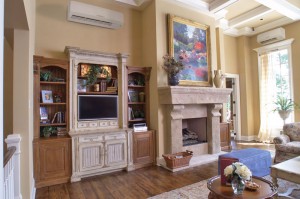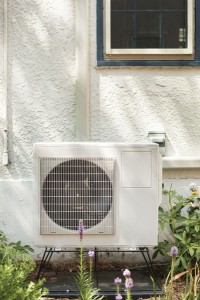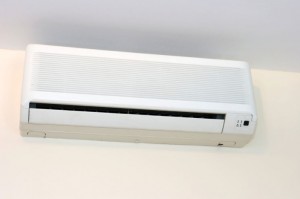 Most people have heard of heat pump technology. More and more these days, heat pumps are providing both heating and cooling for homes and businesses.
Most people have heard of heat pump technology. More and more these days, heat pumps are providing both heating and cooling for homes and businesses.
Traditionally in the U.S., heat pumps have provided either hot or cold air for distribution by blowers, through air-ducts and registers in ceilings, floors and walls. Heat pumps are employed because they provide heating and cooling with only one system, and, on an operating-cost basis, unless you have natural gas, they are competitive or superior to conventional electric heaters and furnaces, as well as systems fired by oil, kerosene or propane. Sometimes they are used solely as a more efficient way of cooling air than traditional swamp coolers or window air-conditioners.
What many people may not realize is that a new type of heat pump has been on the market over the last ten or so years that has revolutionized the technology and the way that people perceive and experience heat pumps. Mini-split heat pumps, sometimes employed with ducted systems, and moe often with ductless systems, have really caught the attention of the heating and cooling industry, builders, architects and designers in the last few years.
 The technology for mini-split heat pumps was developed in Japan after WWII in response to climate, crowding, building technology, and high electricity rates. Mini-splits are quiet, efficient, flexible in their application, and typically very reliable in use. They are called “mini” because they are significantly more compact for a given capacity than conventional units. They are called “splits” because they are split into two parts: the outside unit with a compressor, large fan, condenser, sensors and controls; and an indoor unit which is much smaller and quieter, and features more sophisticated sensors, air distribution technology, and styling for compatibility with interior décor.
The technology for mini-split heat pumps was developed in Japan after WWII in response to climate, crowding, building technology, and high electricity rates. Mini-splits are quiet, efficient, flexible in their application, and typically very reliable in use. They are called “mini” because they are significantly more compact for a given capacity than conventional units. They are called “splits” because they are split into two parts: the outside unit with a compressor, large fan, condenser, sensors and controls; and an indoor unit which is much smaller and quieter, and features more sophisticated sensors, air distribution technology, and styling for compatibility with interior décor.
These mini-split systems are amazingly quiet and efficient at maintaining a set temperature and humidity level no matter the outside temperature. They are sometimes called ductless mini-split systems because usually these units are installed by running two small insulated copper tubes (1/4” or 3/8”), plus a small electrical cable, from the outdoor unit through a wall or ceiling to the indoor unit, which is typically mounted high on an interior wall or ceiling. The wall penetrations typically are 3 inches in diameter or less, and lines can be concealed and protected very easily in 3-inch conduits or plastic channel-like downspout material.
Since expensive ducting is usually not required, mini-split systems typically cost much less to install than ducted systems. If you already have a ducted system in your home or building, these systems can be adapted to work with them; just be aware that older ducted systems are typically leaky and not well-insulated; in that scenario, most of the advantage a mini-split may be lost. Many times nowadays the old ducts are abandoned and mini-splits are installed without ducts.
Mini-splits are available now that can be individually controled from one to over thirty indoor zones with heating or cooling from the same system, at the same time. The individual units are controlled by small sophisticated remotes that are programmable and offer many choices about the way the unit operates.
 I have had one of these systems working in my small home for over five years, and I am very happy with it. There have been no service calls necessary, and no repairs. I live at an elevation of about 3500 feet in the Northern California mountains; we get some pretty cold temperatures up here and this system keeps cranking out the heat.
I have had one of these systems working in my small home for over five years, and I am very happy with it. There have been no service calls necessary, and no repairs. I live at an elevation of about 3500 feet in the Northern California mountains; we get some pretty cold temperatures up here and this system keeps cranking out the heat.
My mini-split system replaced electric baseboard heaters. It’s paid for itself almost two times now, and my place is more comfortable than it used to be. The system has to work harder at very low temperatures, but keeps working right down into the single digits. My system is a Mitsubishi; they are also made by Fujitsu, Daikin and many others. My understanding is that the Japanese still have the edge in design and quality control on these systems, but others are striving to catch up.
I installed my own units (in different homes) and had a professional start them up. Do your homework or hire an experienced contractor to do the job for you. You may find you save money overall, as well as energy.
Posted in: Community, Environment
Comment Policy: All viewpoints are welcome, but comments should remain relevant. Personal attacks, profanity, and aggressive behavior are not allowed. No spam, advertising, or promoting of products/services. Please, only use your real name and limit the amount of links submitted in your comment.
You Might Also Like...

Pet Safety: Hugs Are For Humans!
Saving the hugs for humans can prevent an unsolicited bite, or scratch, or worse. We’ve seen them posted online or traded between phones: the adorable home video clips capturing kid-and-pet […]
Feeling Drab or Disheveled? Five Tips To Beautify While Living A Chaotic Life
I confess … on occasion I do apply a final coat of mascara while sitting in the car at a red light. I know this behavior does not represent my finest […]

Horses & Hoofprints on Hearts
Horses In The North State Provide A Multi-Faceted Education For Kids A meme is floating around the internet featuring an image of two pictures of horses. The first picture depicts […]

Families That Grow Cooperatively – Building A Better Community … One Neighborhood And School At A Time
Sharing … involvement … community building … these are just some of the concepts that come to mind when describing a cooperative enterprise. Cooperative living arrangements and cooperative schooling are […]


